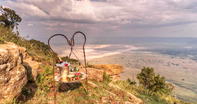
Ngorongoro Crater - A Garden of Eden
Much has been written of the Ngorongoro Crater and its unique ecosystem but it is only when sitting in the middle of the crater surrounded by the rising walls on all sides that the real effect is appreciated. Here a hole in the ground formed by a volcanic explosion, and covered over time in wind-blown earth and vegetation, has developed into a natural wildlife theme park.
Over time, the Ngorongoro Crater (a collapsed volcano), has turned into a veritable 'Garden of Eden' - a wildlife paradise protected by a circular unbroken 610m (2,000-foot) wall. This giant natural amphitheatre is home to up to 30,000 animals, half of which are zebra and wildebeest. This provides plenty of food for the main predators; lions and spotted hyenas, although there are also lots of jackals and some leopards and cheetahs. Black rhino are usually seen in the Ngorongoro Crater, as are large herds of buffalo.
There are estimated to be about 24 000 animals inhabiting the crater at any one time - most of which are permanent residents. Often thought to be a natural enclosure it is now known that a large percentage of wildebeest and zebra leave the crater during the rainy season. Lions however have had very little input from outside the crater over the years and this has led weakening of the crater gene pool, causing a great deal of problems with the lions
The vegetation and landscapes in the crater represent most of the eco-zones of northern Tanzania and include forest, grassland, swamp and lake. It is almost as if the crater was developed to protect the various aspects of the Tanzania wilderness in the event of some natural catastrophe. Reality programs of today, in the striving for better viewer ratings, would struggle to set up something so unique.
How Was the Ngorongoro Crater Formed?
It is believed that there was a mountain in Africa that was higher than Kilimanjaro, Africa's highest point at present, and that like many mountains in the area it was volcanically unstable leading to a great eruption that sent lava spewing for hundreds of miles around. Much of this lava settled on the plains to the north of the now gaping mountain.
Over time wind-blown dust and seeds settled in the hole left by the explosion and plants began to grow in the shallow ground. Nutrients did not have far to sink thus keeping the soil fertile and the plants rich in nutrients.
With the steep-sided walls of the crater ensuring a high runoff from rain and mist the crater has sufficient water to provide for the wildlife in a lake and swamp area. The lake, with its high nutrient content, provides rich feeding for thousands of flamingoes that flock to the crater and the swamp provides greenery and water year round.
Birthplace of Man
Olduvai Gorge, not far from the Ngorongoro Crater, is thought to be place where man first walked on earth. In 1960 Mary Leakey discovered a 1.75 million-year-old Homo habilis here, whom she nicknamed the 'Handyman', as he was the earliest known toolmaker.
He was man's first step on the ladder of human evolution and before him the landscape contained giant pigs with metre long (3-foot) tusks, sheep-like creatures with 2-metre (6-foot) horns and three-toed horses.
Nowadays, the Ngorongoro area is home to the tall and proud red-robed Maasai, who daily tend their herds of cattle, sheep and goats in an area that most of us would be privileged to see just once in our lifetime. Cultural encounters with the Masai enrich any East African safari experience.
Climate of Ngorongoro
Ngorongoro safari lodges are situated on the rim of the crater, which is 2,235 metres (7,264 feet) above sea level. It can get quite fresh up here, and gets very cold at night in the winter months of June, July and August, but is opposingly hot down in the crater during the day.
Dry Season
The weather is usually dry from June to October. July is the coldest month and highland temperatures may fall below freezing. Dust and smoke from frequent fires can reduce visibility.
Rainy Season
It rains anytime from November to May, which starts off hot then calms down to very pleasant warm days, with cool nights. The forested eastern slopes get much more rain than the arid country to the west. The amount and pattern of rainfall varies greatly and a dry period in January and February may split the rainy season into short and long rains. The rain arrives in stormy showers usually during the afternoon and at night, which cleanses the air to reveal lovely clear views.
Ngorongoro Crater Safari Lodges
Ngorongoro Crater Safari lodges are situated around the crater rim and have fabulous views. Each morning game-viewing vehicles descend into the amazing wildlife haven that is the Ngorongoro Crater, and spend the day amongst the animals. All vehicles must return before dusk and leave the animals in peace during the hours of darkness.
See Ngorongoro Crater Safari Lodges in Tanzania.

 Ngorongoro Crater is the main highlight of the Ngorongoro Conservation Area in Tanzania. See recommended Ngorongoro Crater safari lodges, to...
Ngorongoro Crater is the main highlight of the Ngorongoro Conservation Area in Tanzania. See recommended Ngorongoro Crater safari lodges, to... The Ngororongoro Crater is the most unique wildereness area in Africa. Today the crater is home to a multitude of wildlife, attracted by the...
The Ngororongoro Crater is the most unique wildereness area in Africa. Today the crater is home to a multitude of wildlife, attracted by the...